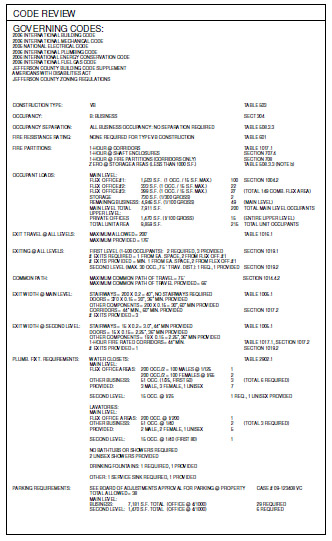In architecture school we are taught that an architect must be able to “wear many hats”, as a metaphor for the many different roles that an architect should be ready to play. I experienced a good dose of this theory in practice yesterday when it became necessary to put on the diplomat hat and seek quick resolution and understanding when a hiccup in the municipal processes of Jefferson County caused a delay and possible rejection of a critical permit application.
As several articles on this website have pointed out in recent weeks, many local building departments (including Jefferson County) will be switching to the 2009 Versions of the International Codes over the next few months. Jefferson County, in fact, will be switching as of January 1st, tomorrow. While we only learned that Jefferson County would be one of the very first jurisdictions in Colorado to make this switch little more than a month ago, we make a constant effort to assure that we are on top of all of the current regulations in any of the many jurisdictions that we do work in. We have spent much of the last month training on the code changes and making sure that we understand and inform all of our current clients on the ramifications that the code changes would have on projects in the works that haven’t submitted for permit yet. In addition, we have had to expedite the design and construction documentation process over the last month for several projects that the impending code changes would require costly redesign or make infeasible.
It created the critical situation where the necessary construction documents and permit application for a couple of our commercial tenant finish projects must be accepted into the logs of the Building Department before the deadline causes them to become subject to the modified code.
The speculative nature of commercial leasable tenant spaces causes something of an “exploration of the possibilities” at the beginning of the design process. This involves completing a thorough Code Analysis for the space itself and the building (whether new construction or existing) that the space is in. The Code Analysis then becomes a Code Review that is included in the construction documents, outlining all of the different codes that the space is subject to and carefully analyzing how those codes affect what is possible in the space. One space may be subject to a long list of various Codes including the building code, accessibility codes, Zoning Codes and many more. The Code Analysis also happens in conjunction with balancing the needs of the building Owner for the overall building and property, the program requirements of the particular tenants interested in the spaces within the building, the concurrent design of all of the building systems (mechanical, electrical, plumbing, structural, etc.), the existing conditions and the needs of the contractors involved. The ability to understand and then weave together and manage all of these different pieces of the puzzle into a design that becomes a whole, fully functioning building or space (and yet make it look nice too!) is what the real function of an Architect is all about. In addition, the Codes themselves are often ambiguous and open to some degree of interpretation. Throughout this “exploratory process”, there are many questions that must be raised, including asking the jurisdiction itself (and different departments within the Jurisdiction) how they might interpret a portion of code, which may be vastly different than how you or another member of the design team has interpreted it. A plan will go through many evolutions and iterations as the exploration process unfolds, until it is settled upon by the stakeholders involved (owner, design team, tenant, etc.), and the construction documents are completed and coordinated in preparation for submittal to the Jurisdiction.
Because of the critical timeline over the past month on the projects that we determined would benefit by being submitted prior to the code change, we spent some extra due diligence time with the county and other individuals going over our interpretations of the Code and making sure that we had a stable understanding of how they would look at the projects when they were submitted. Prior to our involvement in the design team, similar conversations had taken place between the Owner and the Planning & Zoning Department during the “exploration process” early in the planning process. The early comments of the Planning & Zoning Dept. were incorporated into the evolutions of the plans, along with the subsequent comments of the Building Department, the Fire Marshall and other individuals. However, because of the conversations with the Owner early in the process, the Planning & Zoning Dept. had a preconceived idea of what the project was going to be that turned out to be quite a bit different than what it became after the various evolutions in the plan. This caused the Planner reviewing the submittal for permit and then the Zoning Administrator to have some concerns about the intended uses for the space and thus causing them to delay acceptance of the application. The Zoning Administrator wanted to avoid having to issue violations after the space was occupied for uses that were not allowed according to the Zoning Resolution. This is normally an issue that would be resolved over the course of a day or two with conversations between the Zoning Administrator and the Building Owner, allowing the Zoning Administrator to assure that the Building Owner is aware of what is (and what is not) an allowed use of the building and avoiding the need to issue violations in the future. The changes in the Building Code (and impending deadline for submittal), however, do not necessarily affect the Planning & Zoning Department (they are subject to the County Zoning Resolution) and yet the application must first be submitted to the Planning & Zoning Department before proceeding to the Building Department for processing.
Thus a somewhat small Planning & Zoning issue became a major hurdle impeding the critical timeline for having the application logged with the Building Department prior to the deadline!
These types of issues can be frustrating when so much hard work and diligence has gone into creating a well put together set of construction documents and the attempt to avoid issues in the submittal process but we were able to quickly throw on that “Diplomat Hat” and go to bat in behalf of the client in order to help the Zoning Administrator understand the process of evolution that the design had gone through and the critical nature of getting the plans into the Building Department in time. We were able to successfully expedite the process through conversations with the Zoning Administrator allowing him to accept the plans and forward them on to the Building Department in time!!!










